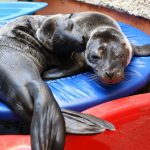A happy pup will thrive, grow well, and be released quickly. However, knowing what factors in of the pup’s rehab environment lead to a happy pup may not be that obvious. The key to a happy pup is trying to mimic, as far as possible, the social and physical conditions for a pup of that species and age.
For a harbour (common) seal pup, we know that in the wild the newborn pup
- swims and has access to water from birth
- is constantly beside its mother, both on shore and in the water, for at least the first 10-14 days
- follows its mother closely in the water, probably following her body odour
- plays with its mother in the water (somersaulting over and around her)
- cries when distressed, usually when separated from its mother
This list therefore forms the basis for a ‘wish list’ for a pup in rehab. From scrutiny of this list, it is immediately obvious, for example that a pup placed alone in a pen with no swimming water or companion will be an unhappy pup, who will probably cry continuously.
The water problem is easily solved. A child’s paddling pool is ideal for a young harbour seal pup. Once you are certain that the pup can get out of the pool unaided when it has had enough, most pups can be left with continuous access to a paddling pool. We find a mini-trampoline functions as an excellent ‘haul-out rock’ beside a paddling pool, and makes the entry and exit to the pool easy for the youngest pup.
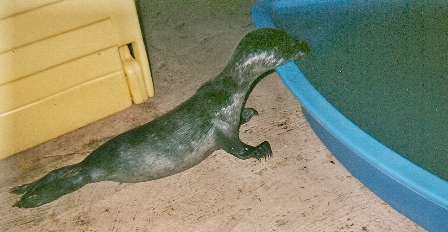
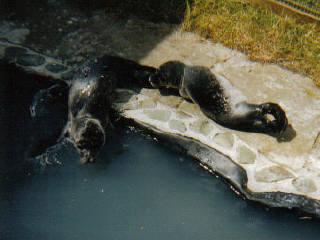
Newborn Maris takes an interest in the paddling pool Newborn Rona takes the plunge while Star watches
The next thing is companionship. The harbour seal pup should be constantly beside its mother, and therefore in rehab needs some form of surrogate mother. The ideal surrogate is in fact another pup. Where there is another pup in the rehab facility, therefore, the pups should be kept together. Exceptions to this would be if one pup is ill (it should be kept separately until it is well again) or if there is an incompatibility between the pups (this is rare). Each pup acts to a great extent as a mother substitute for its companion pup. They follow one another very like the way in which a pup follows its mother, they smell each other, they sleep together and they play together. They may also suckle on one another – this should be watched, in case one pup suckles too vigorously or frequently on the other, but we have not found this to be a problem. Pups kept in pairs rarely cry.
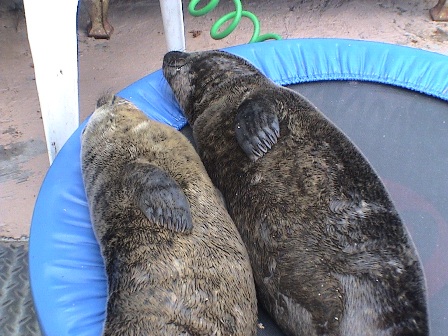
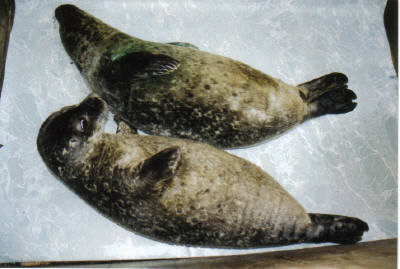
Emil and Silver sleeping together on the mini-trampoline Evie and Olly asleep in their ‘bedroom’ (a large dog kennel)
Our pup pairs (Tara and Caelan, Finn and Tinkerbell, Rona and Star, Evie and Olly, Emil and Silver) have always chosen to sleep together, either in their shelter or on their mini-trampoline. A healthy pup usually sleeps lying on its side, as in this photo of Emil and Silver.
Rambunctious play should never be a cause for concern. It is not ‘fighting’, and wil not develop into fighting. Play between two seals in the wild involves following and somersaulting backwards over each other. sometimes while splashing vigorously, and sometimes more slowly and gently. They can do it for hours at a time! Young seals in the wild seem to choose very shallow water of just a few feet for play beside the haul-out site, so in fact the rehab conditions in a paddling pool are ideal! Two rehab pups engaging in play is a sign that they are thriving and happy.

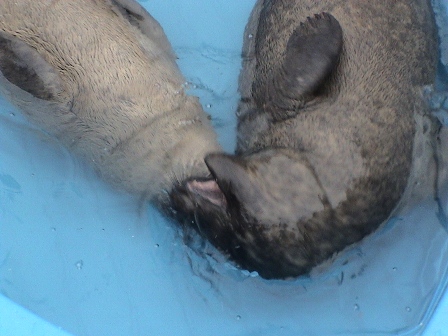
Pup pairs playing Finn and Tinkerbell (left) and Emil and Silver (right)
But what of pups kept singly when there is no companion pup available? We have found different solutions to each individual. Maris demanded freqnt human company, but eventually became contented with our boots or trousers as a substitute, although having someone to sit with her or play with her was her preference. Lora also sought human company, but selected an old (soft fabric) doorstop as a surrogate, which she would suckle energetically. We had to keep repairing this to prevent her ingesting the stuffing, and we also had to try to clean it regularly! Dana liked human company also, but was less dependent on it that Maris or Lora. Although Dana was very docile and easy to handle, she was more ‘self-sufficient’ than many other pups, and did not seem to want any surrogate.
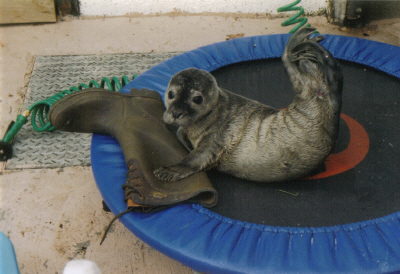
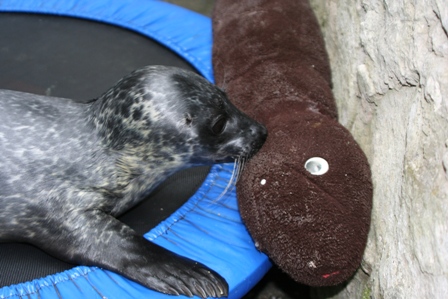
Siingle pups with surrogates – Maris with ‘Bootmummy’ (left) and Lora with ‘Doggle’ (right).
Some pups may also take to a water toy, such as a ball or a plastic bottle (half filled with water).
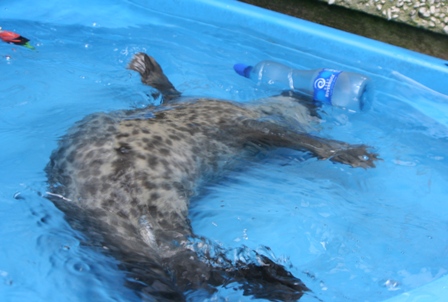
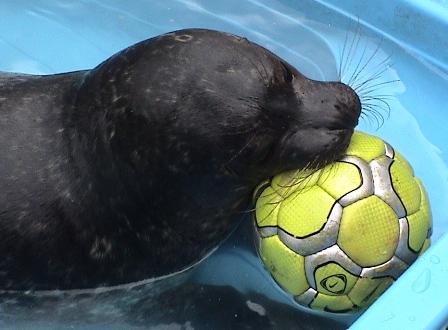
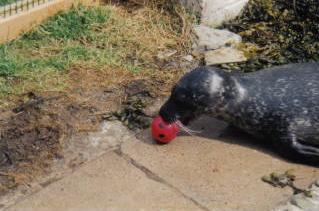
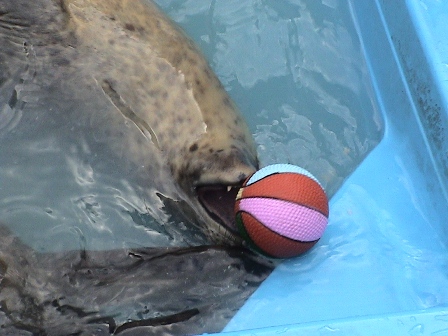
Object-play by pups Lora with plastic bottle (top left), Emil with soft football (top right), Finn squeaking small squeaky ball (lower left) and Silver with small solid ball (lower right)
By various means it is possible to ensure a pup’s well-being while it is in rehab. We are now just embarking on a new research project to try and understand and define pup ‘well-being’ in scientific terms, so the concept may gain wider acceptance and benefit pups in rehabilitation centres worldwide.
It should be noted that the harbour seal’s ‘wish list’ enumerated above would not be applicable to the pups of all species. Grey seal pups, for example, naturally avoid water for the first 10-14 days or so, while they are still wearing the lanugo coat. They should be offered access to water from about 10 days of age, but should not be forced into the water until they are ready. Grey seal pups may also be less social for the first few weeks of life, although individuals vary greatly. The needs of grey seal pups have not yet been carefully enunciated. Other species – such a ringed seals or sea lions – may again have needs which are different from harbour seals. Each species needs separate consideration, although the underlying principles, i.e. of knowing the natural behaviour of the wild animal and attempting to mimic it, are universal.

